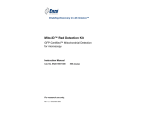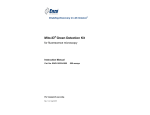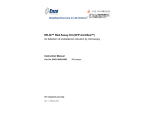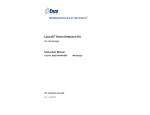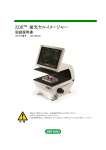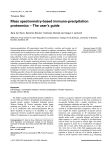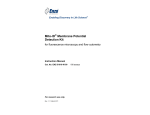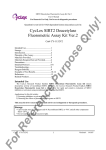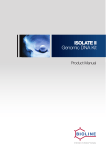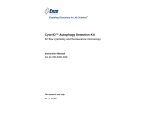Download User Manual-ENZ-51007-500
Transcript
※本プロトコールは参考用の資料になり ます。商品ご購入の際は必ず商品に添付 されている資料をご参照ください。 Enabling Discovery in Life Science® Mito-ID® Red Detection Kit GFP-Certified® Mitochondrial Detection for microscopy Instruction Manual Cat. No. ENZ-51007-500 For research use only. Rev. 1.2.3 June 2011 500 assays Notice to Purchaser ® ® The Mito-ID Red Detection Kit (GFP-Certified Mitochondrial Detection) is a ® member of the CELLestial product line, reagents and assay kits comprising fluorescent molecular probes that have been extensively benchmarked for live cell analysis applica® tions. CELLestial reagents and kits are optimal for use in demanding cell analysis applications involving confocal microscopy, flow cytometry, microplate readers and HCS/HTS, where consistency and reproducibility are required. This product is manufactured and sold by ENZO LIFE SCIENCES, INC. for research use only by the end-user in the research market and is not intended for diagnostic or therapeutic use. Purchase does not include any right or license to use, develop or otherwise exploit this product commercially. Any commercial use, development or exploitation of this product or development using this product without the express prior written authorization of ENZO LIFE SCIENCES, INC. is strictly prohibited. Limited Warranty These products are offered under a limited warranty. The products are guaranteed to meet appropriate specifications described in the package insert at the time of shipment. Enzo Life Sciences’ sole obligation is to replace the product to the extent of the purchase price. All claims must be made to Enzo Life Sciences, Inc. within five (5) days of receipt of order. Trademarks and Patents Enzo, CELLestial, GFP-Certified and Mito-ID are trademarks of Enzo Life Sciences, Inc. Several of Enzo’s products and product applications are covered by US and foreign patents and patents pending. Contents I. Introduction ............................................................... 1 II. Reagents Provided and Storage.............................. 2 III. Additional Materials Required ................................. 2 IV. Safety Warnings and Precautions........................... 2 V. Methods and Procedures ......................................... 3 A. REAGENT PREPARATION ....................................... 3 B. STAINING LIVE, ADHERENT CELLS ....................... 4 C. STAINING LIVE CELLS GROWN IN SUSPENSION ........................................................... 4 D. ALDEHYDE FIXATION AND DETERGENT PERMEABILIZATION OF LIVE CELLS STAINED WITH MITO-ID® RED DYE ........................................ 5 E. STAINING OF ALDEHYDE-FIXED AND DETERGENT-PERMEABILIZED CELLS .................. 6 VI. Appendices ............................................................... 6 A. FILTER SET SELECTION ......................................... 6 B. RESULTS .................................................................. 7 VII. References ................................................................ 8 VIII. Troubleshooting Guide ........................................... 8 I. Introduction Enzo Life Sciences’ Mito-ID® Red Detection Kit (GFP-Certified® Mitochondrial Detection) contains a novel mitochondria-selective dye suitable for live-, detergent-permeabilized- and aldehyde-fixed-cell staining. Conventional fluorescent stains for mitochondria — such as JC-1 (Catalog No. ENZ-52304), rhodamine 123 (Catalog No. ENZ-52307) and tetramethylrhodamine ethyl ester (TMRE, Catalog No. ENZ-52309) — are readily sequestered by actively respiring mitochondria. However, these mitochondrial stains are subsequently leached out of cells once the mitochondria’s membrane potential dissipates. This characteristic severely limits their use in experiments in which cells must be treated with nonionic detergents, aldehyde fixatives or other agents that affect the energetic state of the mitochondria. Sub-micromolar concentrations of Mito-ID® Red dye are sufficient for staining mammalian cells. This has been validated with a human cervical carcinoma cell line, HeLa; a human T-lymphocyte cell line, Jurkat; and human bone osteosarcoma epithelial cell line, U2OS. One important application of Mito-ID® Red dye is in fluorescence colocalization imaging with green fluorescent protein (GFP)-tagged proteins. This is a powerful approach for determining the targeting of molecules to intracellular compartments, and for screening of associations and interactions between these molecules. However to date, photoconversion of red fluorescent dyes to green and metachromatic artifacts wherein fluorescent dyes emit both in the red and green regions of the spectrum have led to spurious results in GFP co-localization experiments.1,2 Additionally, many organelle-targeting probes photobleach rapidly, are subject to quenching when concentrated in organelles, are highly toxic, or only transiently associate with the target organelle, requiring imaging within a minute or two of dye addition.3,4 Enzo’s Mito-ID® Red dye, a new red-emitting, cell-permeable small organic probe molecule that spontaneously localizes to live or fixed mitochondria, was developed to overcome the above problems. The Mito-ID® Red dye can be readily used in combination with other common UV and visible light excitable fluorescent dyes and various fluorescent proteins in multi-color imaging and detection applications. It emits in the Texas Red region of the visible light spectrum, and is highly resistant to photobleaching, concentration quenching and photoconversion. The Mito-ID® Red Detection Kit (GFP-Certified® Mitochondrial Detection) is specifically designed for use with GFP-expressing cell lines, as well as cells expressing blue, cyan or yellow fluorescent proteins (BFPs, CFPs, YFPs). Additionally, the kit is suitable for use with live or post-fixed cells in conjunction with probes, such as labeled antibodies, or other fluorescent conjugates displaying similar spectral properties as fluorescein or coumarin. A nuclear counterstain is provided to highlight this organelle as well. 1 II. Reagents Provided and Storage All reagents are shipped on dry ice. Upon receipt, the kit should be stored at ≤-20°C, protected from light. When stored properly, these reagents are stable for at least twelve months. Avoid repeated freezing and thawing. Reagents provided in the kit are sufficient for approximately 500 assays using either live, adherent cells or cells in suspension. Reagent Quantity ® Mito-ID Red Detection Reagent 10 µL Hoechst 33342 Nuclear Stain 50 µL 10X Assay Buffer 15 mL III. Additional Materials Required • Standard fluorescence microscope • Calibrated, adjustable precision pipetters, preferably with disposable plastic tips • Adjustable speed centrifuge with swinging buckets (for suspension cultures) • Glass microscope slides • Glass cover slips • Deionized water • Anhydrous DMSO (optional) • Growth medium (e.g., Dulbecco’s Modified Eagle Medium, D-MEM) • Formaldehyde (optional, for fixation protocol) • Triton X-100 (optional, for permeabilization protocol) • Mito-ID® Red Antifade Reagent or Mito-ID® Red Antifade Reagent with DAPI (ENZ-53002-M010 or ENZ-53003-M010, optional) IV. Safety Warnings and Precautions • This product is for research use only and is not intended for diagnostic purposes. • The Mito-ID® Red Detection Reagent contains DMSO which is readily absorbed through the skin. It is harmful if ingested or absorbed through the skin and may cause irritation to the eyes. Observe appropriate precautions when handling. • Reagents should be treated as possible mutagens and should be handled with care and disposed of properly. • Observe good laboratory practices. Gloves, lab coat, and protective eyewear should always be worn. Never pipet by mouth. Do not eat, drink or smoke in the laboratory areas. All blood components and biological materials should be treated as potentially hazardous and handled as such. They should be disposed of in accordance with established safety procedures. 2 • To avoid photobleaching, perform all manipulations in low light environments or protected from light by other means. V. Methods and Procedures NOTE: Allow all reagents to thaw at room temperature before starting with the procedures. Upon thawing, gently hand-mix or vortex the reagents prior to use to ensure a homogenous solution. Briefly centrifuge the vials at the time of first use, as well as for all subsequent uses, to gather the contents at the bottom of the tube. A. REAGENT PREPARATION 1. 1X Assay Buffer Allow the 10X Assay Buffer to warm to room temperature. Make sure that the reagent is free of any crystallization before dilution. Prepare enough 1X Assay Buffer for the number of samples to be assayed by diluting each milliliter (mL) of the 10X Assay Buffer with 9 mL of deionized water. 2. Dual Detection Reagent The concentration of Mito-ID® Red dye for optimal staining will vary depending upon the application. Suggestions are provided to use as guidelines, though some modifications may be required depending upon the particular cell type employed and other factors such as the permeability of the dye to the cells or tissues. To reduce potential artifacts from overloading of the cells, the concentration of the dye should be kept as low as possible. Prepare sufficient amount of Dual Detection Reagent for the number of samples to be assayed as follows: For every 10 mL of 1X Assay Buffer (see preparation in step 1) or cell culture medium, add 1 µL of Mito-ID® Red Detection Reagent and 10 µL of Hoechst 33342 Nuclear Stain. NOTE: (a) The dyes may be combined into one staining solution or each may be used separately, if desired. (b) An intermediate 10-fold dilution of the Mito-ID® Red Detection Reagent can be made in DMSO if larger staining volumes are not needed. The intermediate dilution is stable for at least 4 weeks if stored at -20°C. (c) The Hoechst 33342 Nuclear Stain can be diluted further if its staining intensity is much stronger than the red Mitochondrial stain, Mito-ID® Red. (d) When staining BFP- or CFP-expressing cells, the Hoechst 33342 Nuclear Stain should be omitted due to its spectral overlap with these fluorescent proteins. 3 B. STAINING LIVE, ADHERENT CELLS 1. Grow cells on cover slips inside a Petri dish filled with the appropriate culture medium. When the cells have reached the desired level of confluence, carefully remove the medium. 2. Dispense sufficient volume of Dual Detection Reagent (see section V-A2, page 3) to cover the monolayer cells (~100 μL of labeling solution for cells grown on an 18 X 18 mm coverslip). 3. Protect samples from light and incubate for 15-30 minutes at 37°C. 4. Wash the cells with 100 μL 1X Assay Buffer. Remove excess buffer and place coverslip on slide. 5. Analyze the stained cells by wide-field fluorescence or confocal microscopy (60X magnification recommended). Use a standard Rhodamine or Texas Red filter set for imaging the mitochondria. Optionally, image the nucleus using a DAPI filter set and the GFPtagged protein using a GFP/FITC filter set. C. STAINING LIVE CELLS GROWN IN SUSPENSION 1. Centrifuge cells for 5 minutes at 400 x g at room temperature (RT) to obtain a cell pellet. 2. Carefully remove the supernatant by aspiration and dispense sufficient volume of Dual Detection Reagent (see section V-A2, page 3) to cover the dispersed cell pellet. 3. Protect samples from light and incubate for 15 to 30 minutes at 37°C. 4. Wash the cells with 100 μL 1X Assay Buffer. Remove excess buffer. Resuspend cells in 100 μL 1X Assay Buffer, then apply the cells to a glass slide and overlay with a coverslip. 5. Analyze the stained cells by wide-field fluorescence or confocal microscopy (60X magnification recommended). Use a standard Rhodamine or Texas Red filter set for imaging the mitochondria. Optionally, image the nucleus using a DAPI filter set and the GFPtagged protein using a GFP/FITC filter set. 4 D. ALDEHYDE FIXATION AND DETERGENT PERMEABILIZATION OF LIVE CELLS STAINED WITH MITO-ID® RED DYE NOTE: It is NOT recommended to stain with both Mito-ID® Red and the Hoechst nuclear counterstain if they are to be fixed. The recommended method of staining fixed cells is to stain after the cells have been fixed. 1. Stain the cells as described in section C, using a 2,500 fold dilution of the Mito-ID® Red dye instead of the 10,000 fold dilution. After staining with Mito-ID® Red dye, wash the cells in fresh, prewarmed growth medium or 1X Assay Buffer. 2. Carefully remove the growth medium, or 1X Assay Buffer covering the cells, and replace it with freshly prepared medium or buffer containing 3.7% formaldehyde. NOTE: If the growth medium contains serum, the formaldehyde solution should also be prepared in growth medium containing serum. 3. Incubate the cells at 37°C for 15 minutes. 4. After fixation, wash the cells several times in PBS or 1X Assay Buffer. 5. If the cells are to be subsequently labeled with an antibody, a permeabilization step is usually required to enhance the antigen’s accessibility. Incubate the fixed cells in PBS or 1X Assay Buffer containing 0.1% Triton X-100 at room temperature for no more than 5 minutes. 6. Following permeabilization, rinse the cells in PBS or 1X Assay Buffer. NOTE: If desired, standard immunofluorescence staining protocols using fluorescein- or coumarin-based antibody conjugates, or equivalent, may be performed after fixation and permeabilization steps. Antifade compounds using ρ-phenylenediamine are not recommended. If an antifade is desired, we recommend Enzo’s Mito-ID®Red Antifade Reagent (ENZ-53002-M010) or Mito-ID® Red Antifade Reagent with DAPI (ENZ-53003-M010). Try to view the samples as soon as possible after staining for sharper staining. 7. If antifade is desired, remove all liquid. Add one drop of antifade (warmed to room temperature), then carefully add a coverslip over sample, being careful not to introduce air bubbles. For sharper images, the sample may be viewed immediately, or for long term storage, the sample may be allowed to dry overnight before sealing the coverslip. 5 E. STAINING OF ALDEHYDE-FIXED AND DETEGENT PERMEABILIZED CELLS The Mito-ID® Red dye is capable of staining already fixed and permeabilized cells. It is not recommended to stain fixed cells with both Mito-ID® Red dye and the Hoechst nuclear counterstain. 1. Fixation and permeabilization should be performed as described in section D. 2. Perform staining as recommended for adherent or suspension cells (sections B or C) using a 2,500 fold dilution of the Mito-ID® Red dye instead of the 10,000 fold dilution. NOTE: If desired, standard immunofluorescence staining protocols using fluorescein- or coumarin-based antibody conjugates, or equivalent, should be performed before Staining with Mito-ID® Red. Antifade formulations using ρ-phenylenediamine are not recommended. If an antifade agent is desired, we recommend Enzo’s Mito-ID® Red Antifade Reagent (ENZ-53002-M010) or Mito-ID® Red Antifade Reagent with DAPI (ENZ-53003-M010). Try to view the samples as soon as possible after staining for sharper staining. 3. If an antifade agent is desired, remove all liquid. Add one drop of antifade reagent (warmed to room temperature), then carefully add a coverslip over sample, being careful not to introduce air bubbles. For sharper images, the sample may be viewed immediately, or for long term storage, the sample may be allowed to dry overnight before sealing the coverslip. VI. APPENDICES A. FILTER SET SELECTION The selection of optimal filter sets for a fluorescence microscopy application requires matching the optical filter specifications to the spectral characteristics of the dyes employed in the analysis. Consult the microscope or filter set manufacturer for assistance in selecting optimal filter sets for your microscope. 6 Figure 1. Absorption and fluorescence emission spectra, ex/em 558/690nm, for Mito-ID® Red (A) and Hoechst 33342, ex/em 350/461nm (B) dyes. All spectra were determined in 1X Assay Buffer. B. RESULTS Mitochondria are subcellular organelles found in eukaryotic cells, often representing as much as 10% of the total cell volume. Although conventional fluorescent stains for mitochondria, such as JC-1, rhodamine 123 and tetramethylrhodamine, are readily sequestered by functioning mitochondria, they are subsequently leached out of the cells once the mitochondrial membrane potential is dissipated. Mito-ID® Red dye accumulates in the mitochondria regardless of the mitochondrial membrane potential. The dye selectively stains mitochondria of living cells and is relatively insensitive to mitochondrial membrane potential uncouplers of phosphorylation, such as CCCP (carbonyl cyanide 3-chlorophenylhydrazone), as well as ionchannel perturbing drugs, such as valinomycin. In addition to being a live cell-permeable dye, Mito-ID® Red dye is also retained during or after cell fixation and detergent permeabilization. Mito-ID® Red dye has been shown to co-localize with EGFPcytochrome C oxidase chimeric protein in the HeLa-TurboGreenmitochondria cell line (HeLa-mitoGFP, MarinPharm GmbH, Luckenwalde, Germany). Typically, intense red fluorescent staining of the mitochondrial network in the perinuclear region of mammalian cells is readily apparent using Mito-ID® Red dye, often with a more grain-like structure in the sub-plasma membrane region. Mito-ID® Red dye colocalizes with the EGFP-cytochrome C oxidase signal, demonstrating selectivity for mitochondria. 7 VII. References 1. Freundt, Czapiga and Lenardo (2007) “Photoconversion of Lysotracker Red to a green fluorescent molecule” Cell Res. 17 (11):956-958. 2. Nadrigny, Li, Kemnitz, Ropert, Koulakoff, Rudolph, Vitali, Giaume, Kirchhoff and Oheim (2007) “Systematic colocalization errors between acridine orange and EGFP in astrocyte vesicular organelles” Biophys J. 93(3):969-980. 3. Minamikawa, Sriratana, Williams, Bowser, Hill and Nagley (1999) Chloromethyl-X-rosamine (MitoTracker Red) photosensitises mitochondria and induces apoptosis in intact human cells. Journal of Cell Science 112, 2419-2430. 4. Scorrano, Petronilli, Colonna, Di Lisa and Bernardi (1999) Chloromethyltetramethylrosamine (Mitotracker Orange™) Induces the Mitochondrial Permeability Transition and Inhibits Respiratory Complex I: Implications for the mechanism of cytochrome c release” J. Biol Chem. 274, 35, 24657–24663. VIII. Troubleshooting Guide Problem Potential Cause Suggestion Mitochondria are not sufficiently stained. Very low concentration of ® Mito-ID Red dye was used or dye was incubated with the cells for an insufficient length of time. Either increase the labeling concentration or increase the time allowed for the dye to accumulate in the mitochondria once the cells have been transferred to fresh medium. Mito-ID Red dye is nonspecifically binding to the surface. We have noted that certain cell culture surfaces with associated gaskets can absorb the dye. Grow cells on glass coverslips, or try another type of slide. Precipitate is seen in the 10X Assay Buffer. Precipitate forms at low temperatures. Allow solution to warm to room temperature or 37°C, then vortex to dissolve all precipitate. Blue nuclear counterstain is too bright compared to the red mitochondrial stain. Different microscopes, cameras and filters may make some signals appear very bright. Reduce the concentration of the nuclear counterstain or shorten the exposure time. Cells do not appear healthy Some cells require serum to remain healthy. Add serum to stain and wash solutions. Serum does not affect staining. Normal amounts of serum added range from 2% to 10%. ® 8 www.enzolifesciences.com Enabling Discovery in Life Science® NORTH/SOUTH AMERICA GERMANY UK & IRELAND ENZO LIFE SCIENCES INTERNATIONAL, INC. 5120 Butler Pike Plymouth Meeting, PA 19462-1202 USA T 1-800-942-0430/(610) 941-0430 F (610) 941-9252 E [email protected] www.enzolifesciences.com ENZO LIFE SCIENCES GMBH Marie-Curie-Strasse 8 DE-79539 Lörrach Germany T +49/0 7621 5500 526 Toll Free 0800 664 9518 F +49/0 7621 5500 527 E [email protected] www.enzolifesciences.com ENZO LIFE SCIENCES (UK) LTD. Palatine House Matford Court Exeter EX2 8NL UK T 0845 601 1488 (UK customers) T +44/0 1392 825900 (from overseas) F +44/0 1392 825910 E [email protected] www.enzolifesciences.com SWITZERLAND & REST OF EUROPE BENELUX FRANCE ENZO LIFE SCIENCES AG Industriestrasse 17, Postfach CH-4415 Lausen Switzerland T +41/0 61 926 89 89 F +41/0 61 926 89 79 E [email protected] www.enzolifesciences.com ENZO LIFE SCIENCES BVBA Frankrijklei 33 BE-2000 Antwerpen, Belgium T +32/0 3 466 04 20 F +33/0 437 484 239 E [email protected] www.enzolifesciences.com ENZO LIFE SCIENCES c/o Covalab s.a.s. 13, Avenue Albert Einstein FR -69100 Villeurbanne France T +33 472 440 655 F +33 437 484 239 E [email protected] www.enzolifesciences.com












